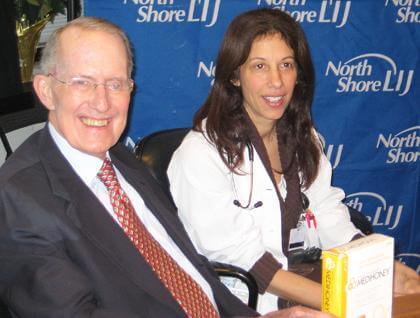By Howard Koplowitz
In his fight against a stubborn bacterial infection on his right leg, Franklin Lloyd found an unlikely ally: honey.
Lloyd, a 68−year−old retired attorney and member of Community Board 11, was advised by his doctors at North Shore University Hospital to use a product called Medihoney, a dressing with anti−bacterial properties made with a medical−grade honey to fight the infection.
Without the honey, Lloyd was in danger of having his leg amputated because he had a kidney transplant 12 years ago and might have had trouble healing if dead skin from the wound was surgically removed.
“The fear was that I’d have to trade my leg for a kidney,” said Lloyd , choking up at a news conference last week. “That was a big concern.”
Dr. Marcia Epstein, an infectious disease specialist at North Shore, diagnosed Lloyd with an infection in his right leg caused by cryptococcus yeast in December 2007.
Lloyd, a Little Neck resident, was given an anti−fungal drug to treat the infection, but the medication was not strong enough.
He was left with an ulcerated wound that covered most of his leg and a bunch of dead skin, which did not help with healing.
At that point, Lloyd’s nurse, Mary Brennan, suggested using Medihoney.
After a month of using the honey dressing, Lloyd saw a huge improvement in the wound.
The dressing is made with honey from manuka and jelly bushes in Australia and New Zealand.
The honey is processed using gamma radiation and is the only type with anti−microbial and anti−inflammatory properties, Brennan said.
Ancient Egyptians started using honey more than 4,000 years ago to treat wounds, according to the hospital.
“Some of the simplest things are worth revisiting,” Lloyd said, noting that he was not surprised that honey had qualities that helped with his healing.
Epstein said because Lloyd only had one kidney, he was in danger of having the leg amputated.
“It was very possible that the leg could have been lost,” she said. “Very possible.”
While Lloyd’s wound has not fully healed, he has made great progress. He said he is looking forward to spending more time with his grandchildren.
He said the wound is now covered by about two Band−Aids.
“They did a great job and I’m so happy,” said Lloyd’s wife, Sally Lloyd.
She said her husband was active with the Community Church of Douglaston, where he designs the church’s Web site, as well as Community Board 11.
While the medical−grade honey helped Lloyd, doctors at North Shore cautioned that honey found in your kitchen cabinet should not be used to treat wounds.
Reach reporter Howard Koplowitz by e−mail at hkoplowitz@timesledger.com or by phone at 718−229−0300, Ext. 173.

































